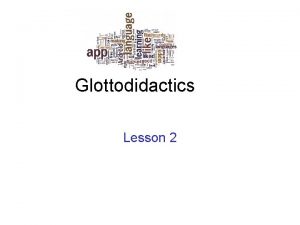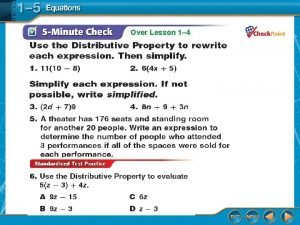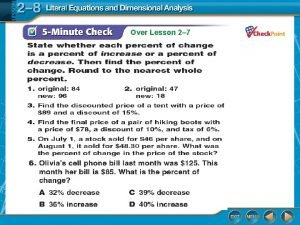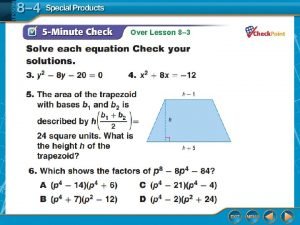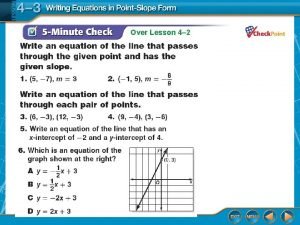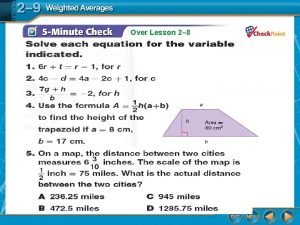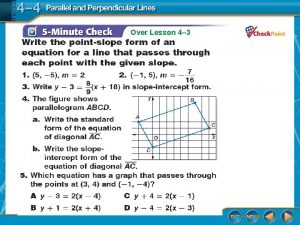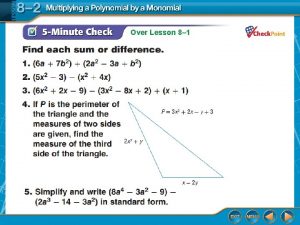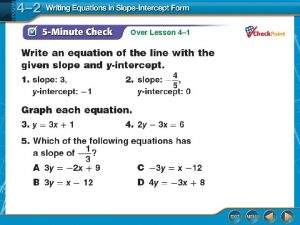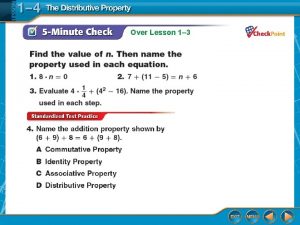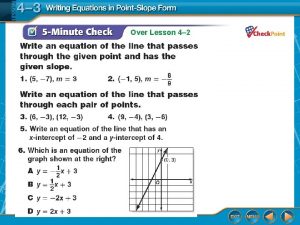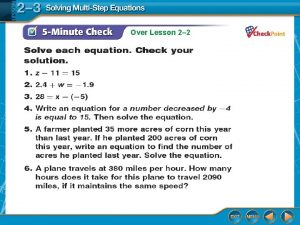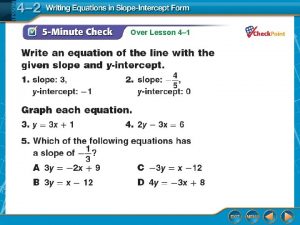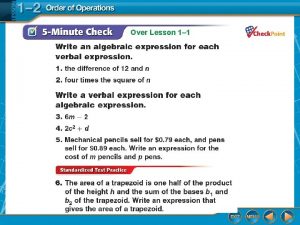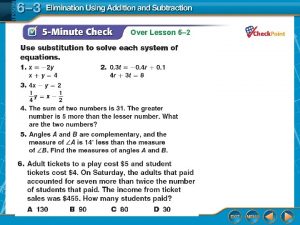Over Lesson 9 6 Over Lesson 9 6






















- Slides: 22

Over Lesson 9– 6

Over Lesson 9– 6

Special Functions Lesson 9 -7

Understand how to identify and graph step functions, absolute value functions and piecewise-defined functions




Greatest Integer Function First, make a table of values. Select a few values between integers. On the graph, dots represent points that are included. Circles represent points that are not included. Answer: Because the dots and circles overlap, the domain is all real numbers. The range is all integers.

A. D = all real numbers, R = all real numbers B. D = all integers, R = all integers C. D = all real numbers, R = all integers D. D = all integers, R = all real numbers

Step Function TAXI A taxi company charges a fee for waiting at a rate of $0. 75 per minute or any fraction thereof. Draw a graph that represents this situation. The total cost for the fee will be a multiple of $0. 75, and the graph will be a step function. If the time is greater than 0 but less than or equal to 1 minute, the fee will be $0. 75. If the time is greater than 2 minutes but less than or equal to 3 minutes, you will be charged for 3 minutes, or $2. 25.

Step Function Answer:

SHOPPING An on-line catalog company charges for shipping based upon the weight of the item being shipped. The company charges $4. 75 for each pound or any fraction thereof. Draw a graph of this situation.

A. C. B.


Absolute Value Function Graph f(x) = │2 x + 2│. State the domain and range. Since f(x) cannot be negative, the minimum point of the graph is where f(x) = 0. f(x) = │2 x + 2│ 0 = 2 x + 2 Original function Replace f(x) with 0. – 2 = 2 x Subtract 2 from each side. – 1 = x Divide each side by 2.

Absolute Value Function Next, make a table of values. Include values for x > – 5 and x < 3. Answer: The domain is all real numbers. The range is all nonnegative numbers.

Graph f(x) = │x + 3│. State the domain and range. A. D = all real numbers, R = all numbers ≥ 0 B. D = all numbers ≥ 0 R = all real numbers, C. D = all numbers ≥ 0, R = all numbers ≥ 0 D. D = all real numbers, R = all real numbers

Piecewise-Defined Function Graph the first expression. Create a table of values for when x < 0, f(x) = –x, and draw the graph. Since x is not equal to 0, place a circle at (0, 0). Next, graph the second expression. Create a table of values for when x ≥ 0, f(x) = –x + 2, and draw the graph. Since x is equal to 0, place a dot at (0, 2).

Piecewise-Defined Function Answer: D = all real numbers, R = all real numbers

A. D = y│y ≤ – 2, y > 2, R = all real numbers B. D = all real numbers, R = y│y ≤ – 2, y > 2 C. D = all real numbers, R = y│y < – 2, y ≥ 2 D. D = all real numbers, R = y│y ≤ 2, y > – 2

Example:

Homework p. 602 #17 -41 odd, Chapter 9 Review
 Over the mountain over the plains
Over the mountain over the plains Siach reciting the word over and over
Siach reciting the word over and over Explain how to handing over and taking over the watch
Explain how to handing over and taking over the watch Brainpop seminole wars
Brainpop seminole wars Lesson 1 trouble over taxes
Lesson 1 trouble over taxes Lesson outline lesson 3 describing circuits answers
Lesson outline lesson 3 describing circuits answers Kind of fault
Kind of fault Lesson outline lesson 2 aquatic ecosystems answer key
Lesson outline lesson 2 aquatic ecosystems answer key Microteaching plan
Microteaching plan Ihi l 101
Ihi l 101 A gift of chappals images
A gift of chappals images Chapter 1 lesson 1 your total health lesson 1 quiz
Chapter 1 lesson 1 your total health lesson 1 quiz Lesson outline lesson 3 answer key
Lesson outline lesson 3 answer key Sat vocabulary lesson 4
Sat vocabulary lesson 4 Physical properties lesson 2
Physical properties lesson 2 Lesson outline lesson 1 solids liquids and gases answer key
Lesson outline lesson 1 solids liquids and gases answer key Climates of earth lesson 1 answer key
Climates of earth lesson 1 answer key Glottodidactics
Glottodidactics Measurement and scientific tools lesson 2 answer key
Measurement and scientific tools lesson 2 answer key Characteristic of fingerprint
Characteristic of fingerprint Unit 1 lesson 1
Unit 1 lesson 1 Lesson 4 gravity and motion lesson review
Lesson 4 gravity and motion lesson review Lesson outline lesson 2 the muscular system answer key
Lesson outline lesson 2 the muscular system answer key

















